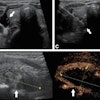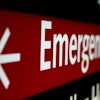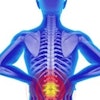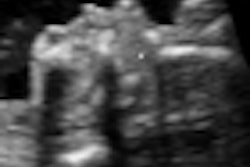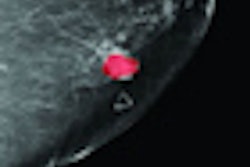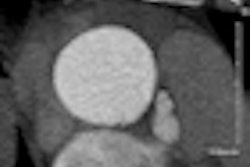NEW YORK CITY - Partially substituting ultrasound for CT in evaluating appendicitis could save the U.S. healthcare system more than $1 billion, according to research presented Saturday at the American Institute of Ultrasound in Medicine (AIUM) annual meeting.
Using data from a variety of sources, a Thomas Jefferson University team projected that utilizing ultrasound first for evaluating appendicitis in the U.S. could save $1.2 billion and prevent 174 cancer deaths each year by avoiding radiation exposure from CT scans. The group's proposed protocol would send patients directly to surgery if they have a positive ultrasound study; those with negative results would still receive a CT scan.
While ultrasound has high positive predictive value for appendicitis and provides low cost and no radiation exposure, the modality appears underutilized in this application, according to Dr. Levon Nazarian. He presented the research findings on behalf of lead author Laurence Parker, PhD.
The researchers sought to estimate the cost and radiation exposure savings for their proposed appendicitis evaluation protocol. To determine the amount and costs of CT and ultrasound performed to evaluate appendicitis, the researchers used the U.S. Centers for Medicare and Medicaid Services (CMS) 5% Carrier, Inpatient, and Beneficiary files for 2007 and the Physician/Supplier Procedure Summary master files for 2007.
They estimated the national incidence of appendicitis and abdominal pain by examining hospital discharge summaries from the National Center for Health Statistics and the Agency for Healthcare Research and Quality.
The study team also performed a meta-analysis of 74 recent research studies to determine the positive predictive value of ultrasound and CT for evaluating appendicitis. To estimate radiation exposure from an average abdominal and pelvic CT, the authors reviewed 30 consecutive patients from their institution's RIS. They then extrapolated the Biological Effects of Ionizing Radiation (BEIR) VII model to estimate excess cancer deaths due to CT appendicitis evaluation.
From their meta-analysis, the authors estimated that ultrasound's sensitivity and specificity was 87.5% and 92.7%, compared with 93.4% and 95.3% for CT. Ultrasound had a positive predictive value of 91% for appendicitis, 1.5% less than CT's positive predictive value of 92.5%.
In estimating the savings from the proposed ultrasound protocol, the researchers assumed that virtually all of the appendicitis cases had presenting symptoms of right lower quadrant abdominal pain. From the 5% Medicare sample that included 1.8 million beneficiaries, the researchers found that 650 patients had appendicitis admissions, and five of these patients were double-coded, leading to 645 unique patients. These patients received 1,288 CT exams of the abdomen and pelvis.
"There was a ratio of one abdominal and one pelvic CT for every case of appendicitis diagnosed in this country," Nazarian said. "But only less than 4% receive an ultrasound. The cost differences between CT and a limited abdominal ultrasound average [$458.53]."
There were also 863 admissions for right lower quadrant abdominal pain. With 650 cases of appendicitis and 863 diagnoses of abdominal pain in the right lower quadrant, the protocol would result in 1,513 limited ultrasound scans being performed to avoid CT on 569 patients (the result of 650 cases multiplied by 87.5% ultrasound sensitivity).
Imaging cost savings in the 5% Medicare sample would total $177,318 and approximately $3.5 million if extrapolated to the Medicare population as a whole. Based on the estimated discharge survey estimates in the U.S. for appendicitis of 300,000 per year, savings would reach $82.5 million, Nazarian said.
More false positives
Noting, however, that the 1.5% differential in positive predictive value between ultrasound and CT would lead to more false positives and excess surgeries, the researchers also estimated those added costs.
With 300,000 cases, there would be 4,500 unnecessary surgeries each year. Considering an average appendectomy cost of $24,878, the total cost for these 4,500 surgeries would be $112 million.
On face value, that's $28.5 million more than the imaging cost savings from the proposed ultrasound protocol, Nazarian said. There would also be 5.4 excess deaths due to the 0.12% hospital surgery death rate.
But radiation exposure savings tilt the advantage back to ultrasound.
From their survey of 30 CT abdominal/pelvic exams at their institution, the researchers estimated the radiation effective dose to be 12.4 ± 5.2 mSv. Based on BEIR VII health risk rates, the ultrasound protocol would eliminate exposure of 3.2 million mSv in the total U.S. population, preventing 174 excess cancer deaths (including the 5.4 added deaths from the excess surgeries).
With the U.S. Environmental Protection Agency's (EPA) estimated value of a human life at $7.4 million, total U.S. savings from preventing these deaths would reach $1.3 billion. Subtracting the added costs from the protocol would lead to a net savings of more than $1.2 billion per year, Nazarian said.
Nazarian acknowledged a number of limitations in their study, including the assumption that it's appropriate to develop estimates for the Medicare population and apply them to the total U.S. population and vice versa.
"I would argue, though, that since appendicitis is so common in younger individuals, you might have more years of life saved [by using ultrasound first] and more cancers that we would induce by doing CTs on the younger population," he said.
In addition, the study assumed that right lower quadrant abdominal pain is the major presenting diagnosis for appendicitis. Also, because excess cancer deaths prevented are not immediate, the researchers need to calculate more precisely the years of life saved, Nazarian said.

